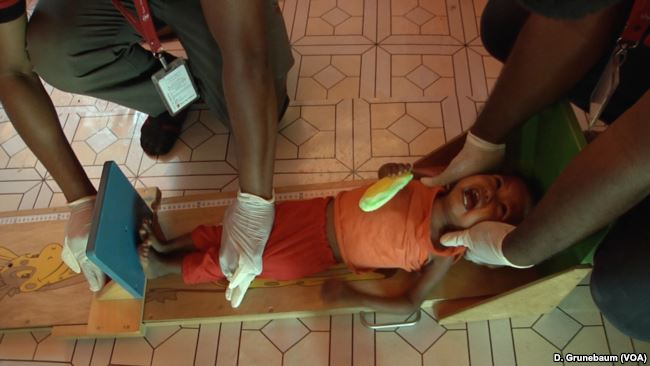
May 09, 2019
“Take a bite,” are the words from Sufiya Begum to her 2½-year-old daughter, Romina Khatun, who is eating special therapeutic food because she has severe acute malnutrition.
Sufiya Begum brings her daughter to a Save the Children nutrition center once a week for an examination. Romina is weighed, her height checked and the circumference of an upper arm measured. About 11% of children younger than 5 in the Rohingya refugee camps suffer moderate to severe acute malnutrition, according to the latest figures available.
This is an improvement compared to 2017, when the figure was almost 20 percent, but it’s still worrisome. Children with severe acute malnutrition are at 10 times greater risk of dying compared to normal children, according to UNICEF. Plus, severe as well as moderate malnutrition can stunt a child’s growth and impact his or her brain.
“Malnutrition is linked to brain development,” says UNICEF nutrition specialist Joseph Senesie, adding that a proper diet is especially important during a child’s first two years. “If the child is not fed well, the child’s brain will not develop well and that will effect their educational consequences and that will effect their productive capacities as they grow up in the future.”
More than 700,000 Rohingya Muslims have fled to southern Bangladesh from neighboring Myanmar because of a military crackdown that started in August 2017. U.N. investigators have said the operation had “genocidal intent.” Myanmar denies the accusations and says its security forces ran a legitimate counterterrorism campaign after attacks by Rohingya militants.
The Rohingya refugees now live in overcrowded camps dependent on humanitarian aid for basic needs.
There are 85 nutrition centers across the camps where children are examined and in cases of severe malnutrition, fed therapeutic food full of protein, vitamins and minerals. The food “actually gives a lot of energy and other minerals that make corrections of the deficiencies,” says Mohammad Ruhul Amin of Save the Children.
Their families are given more therapeutic food to take home for the children to eat between their weekly visits to the center.
“Now we’re getting help with nutrition and my son is healthier and he seems happier too,” says Zainab Bibi, the mother of an 11-month-old boy whose case was upgraded to moderate acute malnutrition from severe. He made this progress in three weeks and his mother credits the therapeutic food as well as the lessons on nutrition and hygiene at a Save the Children nutrition center. The lessons are for mothers and expecting-mothers.
“We hope these lessons can prevent more children from ever becoming malnourished,” says Amin of Save the Children.
There are fruit and vegetable stands in the camps, but many families can’t afford them because they have no income and depend solely on handouts. For many refugees, that means just rice and lentils. Additionally, there are supplemental supplies of nutrient enriched porridge available for all children ages 5 and younger.
“Rice and lentils are not a balanced diet,” Amin says. “It’s very important to have diversified food.”
For many refugees, that’s not possible yet. Currently, about one-third of the refugees are in families that get electronic cards with credit that’s updated monthly to use at specific food markets that sell fresh fruits and vegetables. This system is being phased in as more outlets are built and the U.N.’s World Food Program expects all of the families to have the cards by the end of the year.
Meantime, at nutrition centers across the refugee camps, the work continues to try to help each child have a healthy diet and to teach families about proper nutrition. It’s a challenge with stakes as high as they get.
Photo:Rohingya refugee children get checked for moderate and severe acute malnutrition. Their height, weight and circumference of an upper arm are measured.
